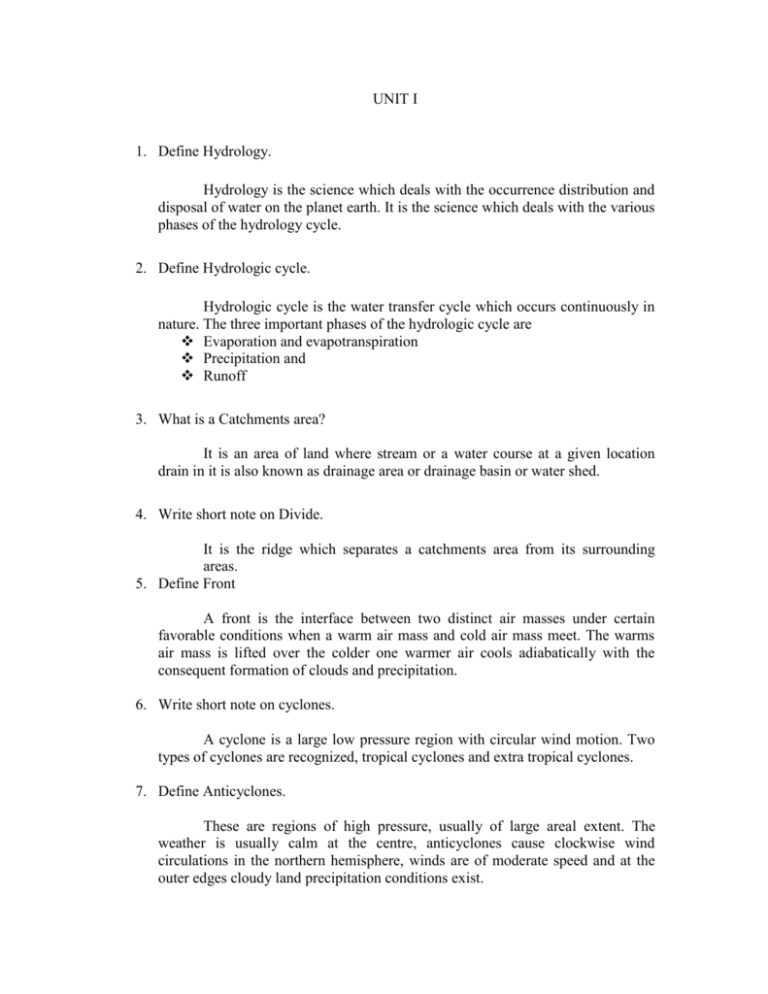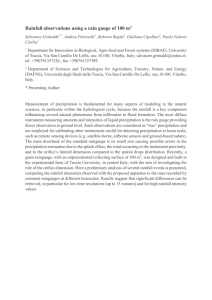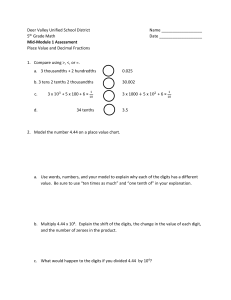hydrology CE601
advertisement

UNIT I 1. Define Hydrology. Hydrology is the science which deals with the occurrence distribution and disposal of water on the planet earth. It is the science which deals with the various phases of the hydrology cycle. 2. Define Hydrologic cycle. Hydrologic cycle is the water transfer cycle which occurs continuously in nature. The three important phases of the hydrologic cycle are Evaporation and evapotranspiration Precipitation and Runoff 3. What is a Catchments area? It is an area of land where stream or a water course at a given location drain in it is also known as drainage area or drainage basin or water shed. 4. Write short note on Divide. It is the ridge which separates a catchments area from its surrounding areas. 5. Define Front A front is the interface between two distinct air masses under certain favorable conditions when a warm air mass and cold air mass meet. The warms air mass is lifted over the colder one warmer air cools adiabatically with the consequent formation of clouds and precipitation. 6. Write short note on cyclones. A cyclone is a large low pressure region with circular wind motion. Two types of cyclones are recognized, tropical cyclones and extra tropical cyclones. 7. Define Anticyclones. These are regions of high pressure, usually of large areal extent. The weather is usually calm at the centre, anticyclones cause clockwise wind circulations in the northern hemisphere, winds are of moderate speed and at the outer edges cloudy land precipitation conditions exist. 8. Explain Thunder storm. Due to the convective instability resulting from unequal heating at the surface or unequal cooling at the top. Small scale disturbances of about 250Km2 area are often created in the moist air in the form of vertical currents. Torrential rain, hail, gusty surface winds, thunder and lightning may all occur in such disturbances. These are called the thunder storms or the convectional showers. 9. Define Tornadoe. Under some conditions the frontal activity may develop into very strong localized convection currents. Such circulatory systems are called the tornadoes and normally have diameter of less than 1.5Km. Their park wind speeds may attain several hundred Km/ hr and their translational velocity may reach 100 Km/ hr. Though they are most destructive their life span is very small often measured in minutes. 10. How does the average intensity of rainfall obtained from mass curve. If any tow points on the rainfall mass curve are jointed by a straight line the slope of that line gives the average intensity of rainfall for the time period between those points denoted by ‘I’ I = ∆p/ ∆t UNIT II 1. Define rainfall intensity. The rate at which the rainfall is accumulating at any given instant of time is called the rainfall intensity at that time. 2. Write short note on rainfall hyetograph. The instantaneous rainfall intensity is usually denoted by (i) and expressed in mm/ hrs. A graph showing the variation of rainfall intensity with time is called a rainfall hyetograph. 3. Define rainfall mass curve. A graph showing the cumulative depth of rainfall against time is known as the rainfall mass curve. 4. Define point rainfall or station rainfall. The rainfall obtained from a single rain gauge station is known as the point rainfall or station rainfall. 5. What is moving average curve. The moving average curve is the plot in which the average value of precipitation of three or five consecutive time intervals is plotted at the mid- value of the time interval is useful in smoothening out the variations & bringing out the long tern trend or pattern. 6. Define Normal rainfall The normal rainfall is the average value of rainfall at a particular date, month or year over a specified 30 year period. It is recomputed every decade. 7. What is a DAD curve ? The average depth of rainfall are plotted against the areas up to the encompassing Isohyets. The curves of maximum depth verses area , with duration are called DAD curves. 8. Define PMP. It has been defined as that depth of precipitation which for a given area and duration can be reached but not exceeded under known meteorological conditions. 9. List out the methods available for estimating missing data. i. ii. iii. iv. v. Interpolation from isohyetal maps. Arithmetic average method. Normal ratio method. Inverse distance method. Regression method. 10. Write down the approaches used for estimating the PMP. Basically two approaches are used for estimating the PMP. They are i. ii. Meteorological Methods The statistical study of rainfall data.







